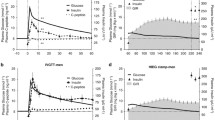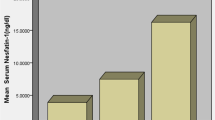Abstract
Metabolic syndrome (MS) is comprised of a cluster of abnormalities in glucose, lipid, and vascular homeostasis, which is most commonly linked to abdominal obesity. MS heralds increased risk for development of diabetes and is linked to impairment in insulin signaling. Insulin-degrading enzyme (IDE) is one of the mechanisms through which insulin blood levels are maintained. It has been previously suggested that controlling IDE levels could provide yet another potential therapeutic approach in diabetes. Here we aim to investigate whether changes in serum IDE levels correlate with the severity of MS. Using a highly sensitive ELISA assay of active IDE in human serum, we found a strong correlation between circulating IDE levels and circulating levels of triglycerides, insulin, and c-peptide and an inverse correlation with HDL cholesterol (HDLc). Serum IDE levels were higher in MS subjects than in control subjects. Hence, circulating IDE may serve as a tool to identify subjects with abnormal insulin metabolism, possibly those with MS that are at risk to develop diabetes.




Similar content being viewed by others
References
S.L. Samson, A.J. Garber, Metabolic syndrome. Endocrinol. Metab. Clin. North Am. 43(1), 1–23 (2014)
R.H. Eckel, K.G. Alberti, S.M. Grundy, P.Z. Zimmet, The metabolic syndrome. Lancet 375(9710), 181–183 (2010)
S.M. Grundy, Metabolic syndrome update. Trends Cardiovasc. Med. 26(4), 364–373 (2016)
W.C. Duckworth, R.G. Bennett, F.G. Hamel, Insulin degradation: progress and potential. Endocr. Rev. 19(5), 608–624 (1998)
J.P. Maianti, A. McFedries, Z.H. Foda, R.E. Kleiner, X.Q. Du, M.A. Leissring, W.J. Tang, M.J. Charron, M.A. Seeliger, A. Saghatelian et al. Anti-diabetic activity of insulin-degrading enzyme inhibitors mediated by multiple hormones. Nature 511(7507), 94–98 (2014)
I.A. Mirsky, R.H. Broh-Kahn, The inactivation of insulin by tissue extracts; the distribution and properties of insulin inactivating extracts. Arch. Biochem. 20(1), 1–9 (1949)
R. Sladek, G. Rocheleau, J. Rung, C. Dina, L. Shen, D. Serre, P. Boutin, D. Vincent, A. Belisle, S. Hadjadj et al. A genome-wide association study identifies novel risk loci for type 2 diabetes. Nature 445(7130), 881–885 (2007)
S. Wiltshire, A.T. Hattersley, G.A. Hitman, M. Walker, J.C. Levy, M. Sampson, S. O’Rahilly, T.M. Frayling, J.I. Bell, G.M. Lathrop et al. A genomewide scan for loci predisposing to type 2 diabetes in a U.K. population (the Diabetes UK Warren 2 Repository): analysis of 573 pedigrees provides independent replication of a susceptibility locus on chromosome 1q. Am. J. Hum. Genet. 69(3), 553–569 (2001)
Y. Marcus, E. Segev, G. Shefer, J. Sack, B. Tal, M. Yaron, E. Carmeli, L. Shefer, M. Margaliot, R. Limor et al. Multidisciplinary treatment of the metabolic syndrome lowers blood pressure variability independent of blood pressure control. J. Clin. Hypertens. (Greenwich) 18(1), 19–24 (2016)
National Cholesterol Education Program (NCEP) Expert Panel on Detection, Evaluation, and Treatment of High Blood Cholesterol in Adults (Adult Treatment Panel III). Third Report of the National Cholesterol Education Program (NCEP) Expert Panel on Detection, Evaluation, and Treatment of High Blood Cholesterol in Adults (Adult Treatment Panel III) final report. Circulation 106(25), 3143–3421 (2002)
R. Azriel-Rosenfeld, M. Valensi, I. Benhar, A human synthetic combinatorial library of arrayable single-chain antibodies based on shuffling in vivo formed CDRs into general framework regions. J. Mol. Biol. 335(1), 177–192 (2004)
I. Benhar, Y. Reiter, Phage display of single-chain antibody constructs. Curr. Protoc. Immunol. Chapter 10(Unit 10), 19B (2002)
R. Hakim, I. Benhar, “Inclonals”: IgGs and IgG-enzyme fusion proteins produced in an E. coli expression-refolding system. MAbs 1(3), 281–287 (2009)
E.G. Kochkina, S.A. Plesneva, D.S. Vasilev, I.A. Zhuravin, A.J. Turner, N.N. Nalivaeva, Effects of ageing and experimental diabetes on insulin-degrading enzyme expression in male rat tissues. Biogerontology 16, 473–484 (2015)
M.A. Kurauti, S.M. Ferreira, G.M. Soares, J.F. Vettorazzi, E.M. Carneiro, A.C. Boschero, J.M. Costa-Júnior, Hyperinsulinemia is associated with increasing insulin secretion but not with decreasing insulin clearance in an age-related metabolic dysfunction mice model. J. Cell. Physiol. 234(6), 9802–9809 (2019)
A. Stargardt, J. Gillis, W. Kamphuis, A. Wiemhoefer, L. Kooijman, M. Raspe, W. Benckhuijsen, J.W. Drijfhout, E.M. Hol, E. Reits, Reduced amyloid-β degradation in early Alzheimer’s disease but not in the APPswePS1dE9 and 3xTg-AD mouse models. Aging Cell 12(3), 499–507 (2013)
I.V. Kurochkin, E. Guarnera, I.N. Berezovsky, Insulin-degrading enzyme in the fight against Alzheimer’s disease. Trends Pharm. Sci. 39(1), 49–58 (2018)
I.V. Kurochkin, E. Guarnera, J.H. Wong, F. Eisenhaber, I.N. Berezovsky, Toward allosterically increased catalytic activity of insulin-degrading enzyme against amyloid peptides. Biochemistry 56(1), 228–239 (2017)
G.R. Tundo, D. Sbardella, C. Ciaccio, G. Grasso, M. Gioia, A. Coletta, F. Polticelli, D. Di Pierro, D. Milardi, P. Van Endert et al. Multiple functions of insulin-degrading enzyme: a metabolic crosslight? Crit. Rev. Biochem. Mol. Biol. 52(5), 554–582 (2017)
E. Standl, H.J. Kolb, Insulin degrading enzyme activity and insulin binding of erythrocytes in normal subjects and Type 2 (non-insulin-dependent) diabetic patients. Diabetologia 27(1), 17–22 (1984)
W.C. Duckworth, J. Fawcett, S. Reddy, J.C. Page, Insulin-degrading activity in wound fluid. J. Clin. Endocrinol. Metab. 89(2), 847–851 (2004)
R. Duggirala, J. Blangero, L. Almasy, T.D. Dyer, K.L. Williams, R.J. Leach, P. O’Connell, M.P. Stern, Linkage of type 2 diabetes mellitus and of age at onset to a genetic location on chromosome 10q in Mexican Americans. Am. J. Hum. Genet. 64(4), 1127–1140 (1999)
S.H. Kwak, Y.M. Cho, M.K. Moon, J.H. Kim, B.L. Park, H.S. Cheong, H.D. Shin, H.C. Jang, S.Y. Kim, H.K. Lee et al. Association of polymorphisms in the insulin-degrading enzyme gene with type 2 diabetes in the Korean population. Diabetes Res. Clin. Pract. 79(2), 284–290 (2008)
N. Vionnet, E.H. Hani, S. Dupont, S. Gallina, S. Francke, S. Dotte, F. De Matos, E. Durand, F. Leprêtre, C. Lecoeur et al. Genomewide search for type 2 diabetes-susceptibility genes in French whites: evidence for a novel susceptibility locus for early-onset diabetes on chromosome 3q27-qter and independent replication of a type 2-diabetes locus on chromosome 1q21-q24. Am. J. Hum. Genet. 67(6), 1470–1480 (2000)
S. Karamohamed, S. Demissie, J. Volcjak, C. Liu, N. Heard-Costa, J. Liu, C.M. Shoemaker, C.I. Panhuysen, J.B. Meigs, P. Wilson et al. Polymorphisms in the insulin-degrading enzyme gene are associated with type 2 diabetes in men from the NHLBI Framingham Heart Study. Diabetes 52(6), 1562–1567 (2003)
H.F. Gu, S. Efendic, S. Nordman, C.G. Ostenson, K. Brismar, A.J. Brookes, J.A. Prince, Quantitative trait loci near the insulin-degrading enzyme (IDE) gene contribute to variation in plasma insulin levels. Diabetes 53(8), 2137–2142 (2004)
X. Lu, Y. Huang, Y. Liu, X. Wu, X. Shi, Variants in the insulin-degrading enzyme gene are associated with metabolic syndrome in Chinese elders. Metabolism 58(10), 1465–1469 (2009)
P. Brandimarti, J.M. Costa-Júnior, S.M. Ferreira, A.O. Protzek, G.J. Santos, E.M. Carneiro, A.C. Boschero, L.F. Rezende, Cafeteria diet inhibits insulin clearance by reduced insulin-degrading enzyme expression and mRNA splicing. J. Endocrinol. 219(2), 173–182 (2013)
W. Farris, S. Mansourian, Y. Chang, L. Lindsley, E.A. Eckman, M.P. Frosch, C.B. Eckman, R.E. Tanzi, D.J. Selkoe, S. Guenette, Insulin-degrading enzyme regulates the levels of insulin, amyloid beta-protein, and the beta-amyloid precursor protein intracellular domain in vivo. Proc. Natl Acad. Sci. USA 100(7), 4162–4167 (2003)
H. Fakhrai-Rad, A. Nikoshkov, A. Kamel, M. Fernström, J.R. Zierath, S. Norgren, H. Luthman, J. Galli, Insulin-degrading enzyme identified as a candidate diabetes susceptibility gene in GK rats. Hum. Mol. Genet. 9(14), 2149–2158 (2000)
S.O. Abdul-Hay, D. Kang, M. McBride, L. Li, J. Zhao, M.A. Leissring, Deletion of insulin-degrading enzyme elicits antipodal, age-dependent effects on glucose and insulin tolerance. PLoS ONE 6(6), e20818 (2011)
K.A. Seta, R.A. Roth, Overexpression of insulin degrading enzyme: cellular localization and effects on insulin signaling. Biochem. Biophys. Res. Commun. 231(1), 167–171 (1997)
X. Wei, B. Ke, Z. Zhao, X. Ye, Z. Gao, J. Ye, Regulation of insulin degrading enzyme activity by obesity-associated factors and pioglitazone in liver of diet-induced obese mice. PLoS ONE 9(4), e95399 (2014)
L. Sacca, G. Orofino, A. Petrone, C. Vigorito, Direct assessment of splanchnic uptake and metabolic effects of human and porcine insulin. J. Clin. Endocrinol. Metab. 59(2), 191–196 (1984)
P.R. Bratusch-Marrain, W.K. Waldhäusl, S. Gasić, A. Hofer, Hepatic disposal of biosynthetic human insulin and porcine C-peptide in humans. Metabolism 33(2), 151–157 (1984)
Funding
The research was supported by Sagol school of neuroscience and the Shoham foundation (to D.F. and Y.S.).
Author information
Authors and Affiliations
Corresponding authors
Ethics declarations
Conflict of interest
The authors declare that they have no conflict of interest.
Informed consent
Consent has been obtained from each patient or subject after full explanation of the purpose and nature of all procedures used.
Additional information
Publisher’s note Springer Nature remains neutral with regard to jurisdictional claims in published maps and institutional affiliations.
Supplementary information
Rights and permissions
About this article
Cite this article
Sofer, Y., Nash, Y., Osher, E. et al. Insulin-degrading enzyme higher in subjects with metabolic syndrome. Endocrine 71, 357–364 (2021). https://doi.org/10.1007/s12020-020-02548-2
Received:
Accepted:
Published:
Issue Date:
DOI: https://doi.org/10.1007/s12020-020-02548-2




